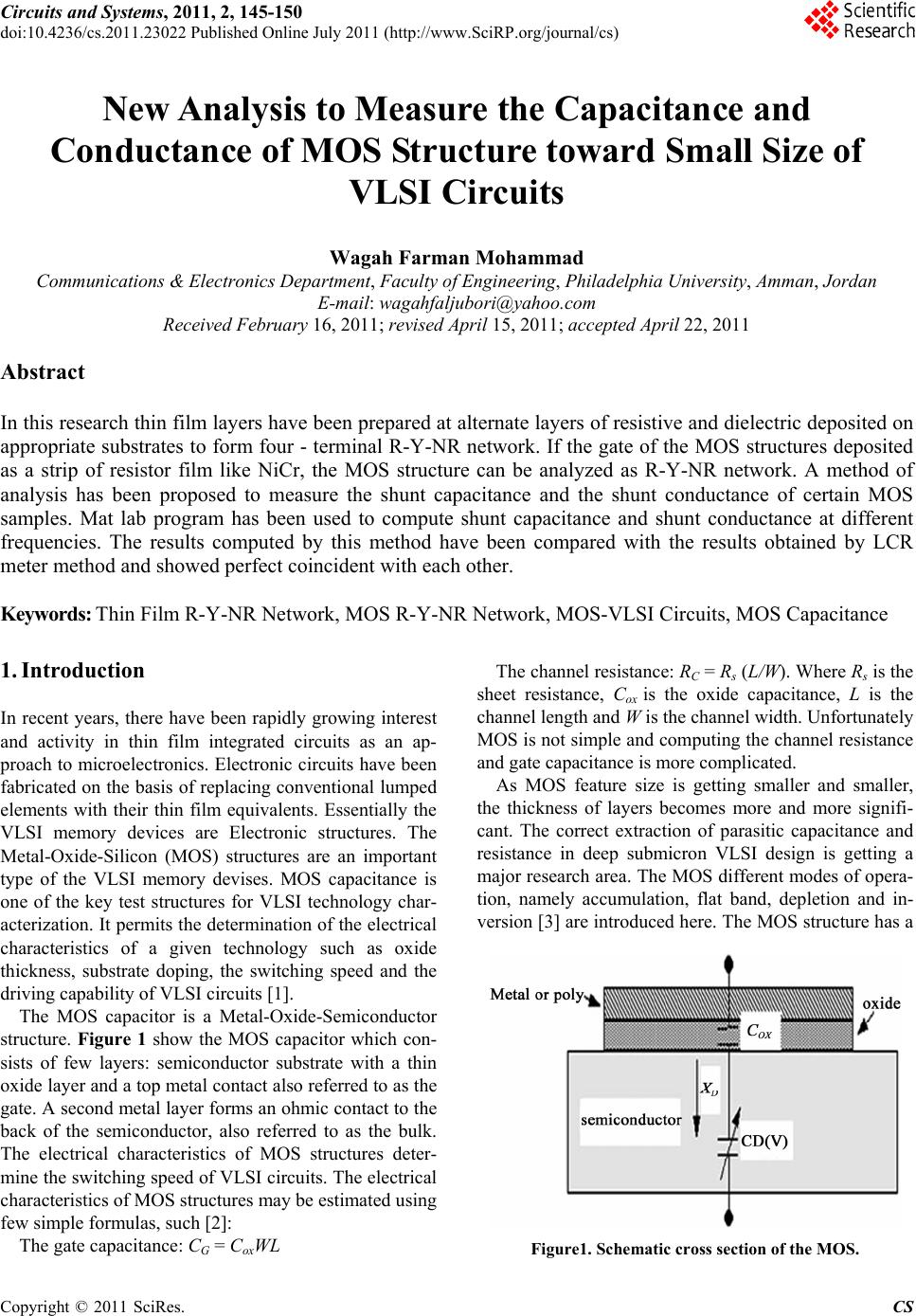
Circuits and Systems, 2011, 2, 145-150
doi:10.4236/cs.2011.23022 Published Online July 2011 (http://www.SciRP.org/journal/cs)
Copyright © 2011 SciRes. CS
New Analysis to Measure the Capacitance and
Conductance of MOS Structure toward Small Size of
VLSI Circuits
Wagah Farman Mohammad
Communications & Electronics Department, Faculty of Engineering, Philadelphia University, Amman, Jordan
E-mail: wagahfaljubori@yahoo.com
Received February 16, 2011; revised April 15, 2011; accepted April 22, 2011
Abstract
In this research thin film layers have been prepared at alternate layers of resistive and dielectric deposited on
appropriate substrates to form four - terminal R-Y-NR network. If the gate of the MOS structures deposited
as a strip of resistor film like NiCr, the MOS structure can be analyzed as R-Y-NR network. A method of
analysis has been proposed to measure the shunt capacitance and the shunt conductance of certain MOS
samples. Mat lab program has been used to compute shunt capacitance and shunt conductance at different
frequencies. The results computed by this method have been compared with the results obtained by LCR
meter method and showed perfect coincident with each other.
Keywords: Thin Film R-Y-NR Network, MOS R-Y-NR Network, MOS-VLSI Circuits, MOS Capacitance
1. Introduction
In recent years, there have been rapidly growing interest
and activity in thin film integrated circuits as an ap-
proach to microelectronics. Electronic circuits have been
fabricated on the basis of replacing conventional lumped
elements with their thin film equivalents. Essentially the
VLSI memory devices are Electronic structures. The
Metal-Oxide-Silicon (MOS) structures are an important
type of the VLSI memory devises. MOS capacitance is
one of the key test structures for VLSI technology char-
acterization. It permits the determination of the electrical
characteristics of a given technology such as oxide
thickness, substrate doping, the switching speed and the
driving capability of VLSI circuits [1].
The MOS capacitor is a Metal-Oxide-Semiconductor
structure. Figure 1 show the MOS capacitor which con-
sists of few layers: semiconductor substrate with a thin
oxide layer and a top metal contact also referred to as the
gate. A second metal layer forms an ohmic contact to the
back of the semiconductor, also referred to as the bulk.
The electrical characteristics of MOS structures deter-
mine the switching speed of VLSI circuits. The electrical
characteristics of MOS structures may be estimated using
few simple formulas, such [2]:
The gate capacitance: CG = CoxWL
The channel resistance: RC = Rs (L/W). Where Rs is the
sheet resistance, Cox is the oxide capacitance, L is the
channel length and W is the channel width. Unfortunately
MOS is not simple and computing the channel resistance
and gate capacitance is more complicated.
As MOS feature size is getting smaller and smaller,
the thickness of layers becomes more and more signifi-
cant. The correct extraction of parasitic capacitance and
resistance in deep submicron VLSI design is getting a
major research area. The MOS different modes of opera-
tion, namely accumulation, flat band, depletion and in-
version [3] are introduced here. The MOS structure has a
Figure1. Schematic cross section of the MOS.